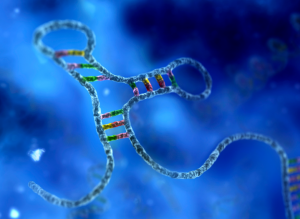Features of RNAiPosted by beauty33 on May 23rd, 2021
①RNAi is a gene silencing mechanism at the post-transcriptional level; ②RNAi has high specificity and only degrades the mRNA of a single endogenous gene corresponding to its sequence; ③RNAi inhibits gene expression with high efficiency, the phenotype can reach the level of deletion mutant phenotype, and a relatively small amount of dsRNA molecules (far less than the number of endogenous mRNA) can completely inhibit the expression of corresponding genes , Is carried out in the way of catalytic amplification; ④The effect of RNAi inhibiting gene expression can cross cell boundaries, transmit and maintain signals over long distances between different cells, and even spread to the entire organism, as well as heritable characteristics; ⑤The dsRNA must not be shorter than 21 bases, and the long-chain dsRNA is also cleaved into siRNA of about 21 bp by Dicer enzyme in the cell, and the siRNA mediates mRNA cleavage. Moreover, dsRNA larger than 30 bp cannot induce specific RNA interference in mammals, but rather inhibits cell non-specific and comprehensive gene expression and apoptosis; ⑥ATP-dependent: The decrease or disappearance of RNA interference in samples with ATP removed shows that RNA interference is an ATP-dependent process. It may be that the digestion reaction between Dicer and RISC must be powered by ATP. Biological characteristics of RNAi RNAi inhibits transposon activity Two aspects of evidence suggest that the inhibition of transposon activity is related to siRNA ① It is found that the worm mut-7 gene is involved in RNAi and is related to the inhibition of transposition by the transposon; ② In Drosophila, the mutation of the RNA helicase Spindle-E involved in RNAi will lead to the loss of gene silencing caused by this gene and at the same time increase the activity of retrotransposons. RNAi protects against viral infections When studying the gene silencing caused by transgene in Arabidopsis, it was found that Arabidopsis with sgs2/sde1 gene mutation showed a high sensitivity to virus infection. RNAi is involved in the formation and maintenance of heterochromatin Hall et al. showed that the centromeric repeat sequences and RNAi components together positively and negatively regulate the formation of heterochromatin and jointly promote the assembly of heterochromatin into nuclei; Vople et al. are knocking out fission yeast (S. pombe) RNAi pathway genes (such as Argonaute, Dicer, RDRP) found that the dsRNA transcribed from heterochromatin can be processed into si RNA with the participation of the RNAi pathway, and the si RNA recruits heterochromatin protein 1 (HP1), and then causes targeted Silencing the transgene in the corresponding heterochromatin region. RNAi is involved in the developmental regulation and physiological metabolism of the body RNAi only inhibits transcribed genes, so RNAi has advantages in biological development research. Chuang et al. used RNAi technology to further confirm the functions of known functional genes such as AG, CLV3, AP1, and PAN in the development of Arabidopsis flowers. The RISC complex formed in the RNAi process can use si RNA or stRNA to perform different functions according to different situations, but ultimately all lead to specific gene silencing. About us BOC RNA is a sub-brand of BOC Sciences, which mainly focuses on RNA technology and its broad prospects in disease treatment. Like it? Share it!More by this author |



